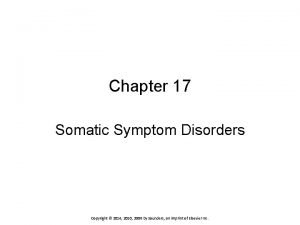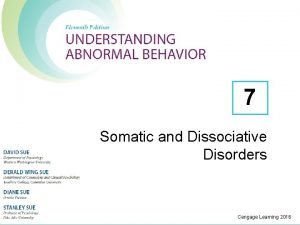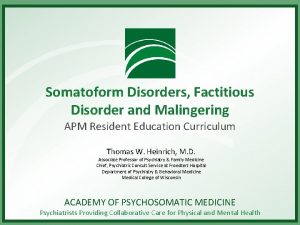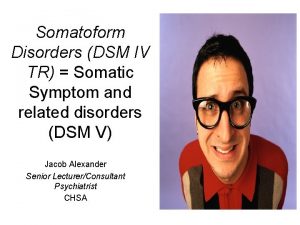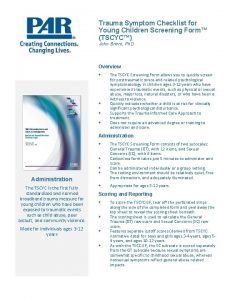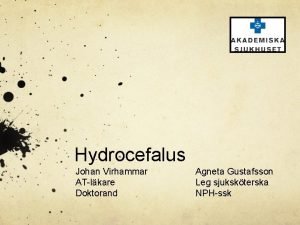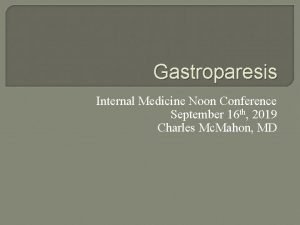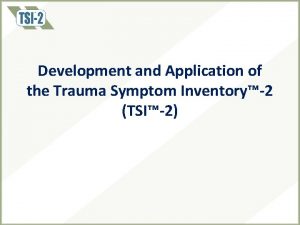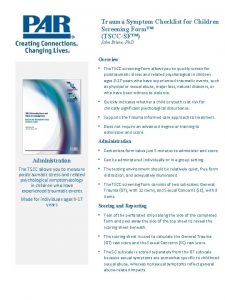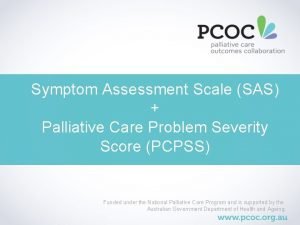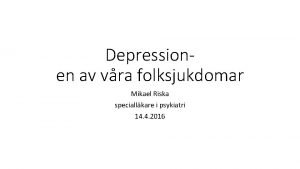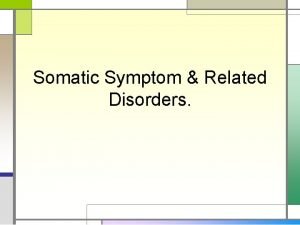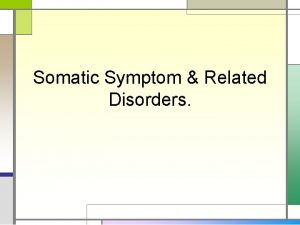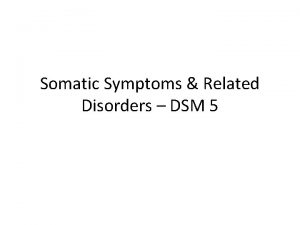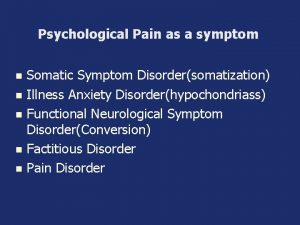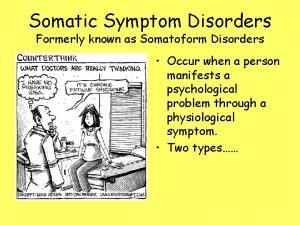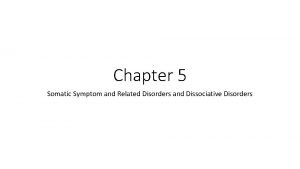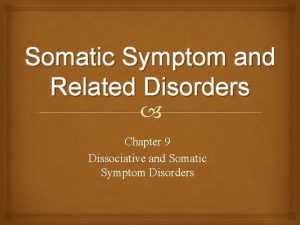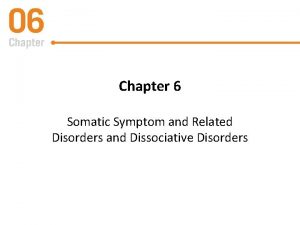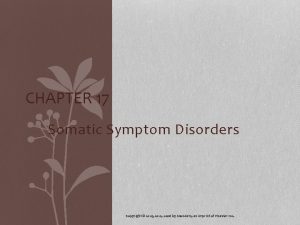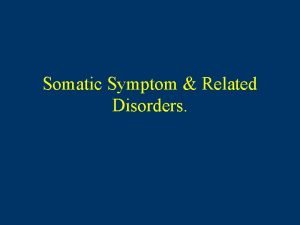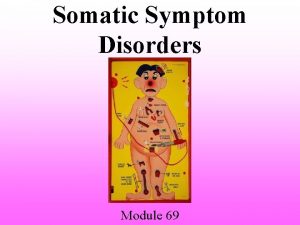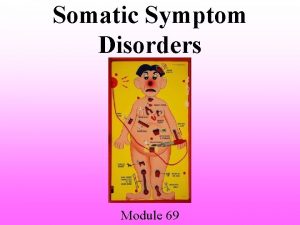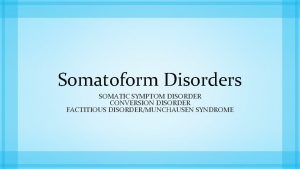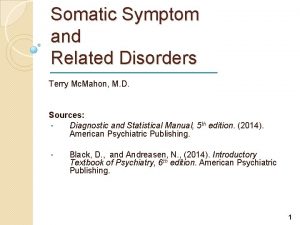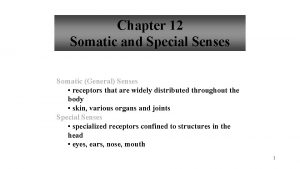CHAPTER 17 Somatic Symptom Disorders 1 Somatize Somatize


























- Slides: 26

CHAPTER 17 Somatic Symptom Disorders 1

Somatize • • Somatize is the tendency to experience and communicate physical symptoms in response to psychologic distress. Although medical tests repeatedly demonstrate no medical basis, people continue to seek relief from their somatic symptoms. 2

Somatic Symptom Disorders • Physical symptoms suggest a physical disorder for which there is no demonstrable base • Strong presumption that symptoms linked to psychobiological factors • Thus, these disorders are physical manifestations of emotional states • Associated with increased health care use, functional impairment, provider dissatisfaction, psychiatric co-morbidity, and failed treatment response. 3

Clinical Picture • Somatic symptom disorder (SSD) • Predominant pain subtype • Illness anxiety disorder (previously hypochondriasis) • Conversion disorder (functional neurologic disorder) • Psychological factors affecting medical condition • Factitious disorder 4

Somatic Symptom Disorder (SDD) • Distressing symptoms • Maladaptive response • Without significant physical findings and medical diagnosis • Suffering is authentic • High level of functional impairment • Predominate Pain subtype 5

Illness Anxiety Disorder (formerly hypochondriasis) • Misinterpretation of physical sensations • Preoccupation with having or acquiring serious illness for at least 6 months • High anxiety about health • Excessive health-related behaviors or maladaptive avoidance • Course of illness chronic and relapsing 6

Conversion Disorder • Neurological symptoms in the absence of a neurological diagnosis • Presence of deficits in voluntary motor or sensory functions • Common symptoms—paralysis, blindness, movement and gait disorders, numbness, paresthesias, loss of vision or hearing, or episodes resembling epilepsy • “La belle indifférence” versus distress 7

Case Study: Conversion Disorder • Frederic is a sales representative for a jet corporation. His sales have been lagging, and his boss tells him, “In 3 weeks, I want you to make a presentation to 200 buyers. If you succeed in making sales, then you can keep your job. ” • Frederic works day and night and prepares an excellent presentation using the latest media technology. The day arrives, and Frederic is ready. When he begins the presentation, he is unable to see. No medical reason can explain his blindness. • Discuss what has probably happened to Frederic related to a conversion disorder. What is the likely outcome? Frederic is taken to the emergency department, where he tells you, “I’m having a nervous breakdown!” What is your best response? 8

Psychological Factors Affecting Medical Condition • Psychological factors present risk for medical diseases • Depression • Cardiovascular diseases and cancer 9

Case Study June, a 57 -year-old accountant, has complained of chronic, severe lower back pain for the last 15 years. Numerous and expensive diagnostic tests reveal mild degenerative joint disease. When June arrives at the office on Monday mornings, she is “grumpy” and takes most of the morning to accomplish small tasks. Coworkers feel obligated to listen to June’s complaints but are growing weary. June is scheduled for a magnetic resonance imaging (MRI) study on Wednesday. She will be out of the office that day; however, when she returns to work on Thursday and Friday, she accomplishes little. (Continued) 10

Audience Response Questions Based on June’s complaints, and considering that diagnostic tests have not revealed anything that would account for her severe pain, which of the following might be an appropriate DSM-5 diagnosis? A. Somatization disorder B. Undifferentiated somatization disorder C. Hypochondriasis D. Somatic symptom disorder with pain 11

Case Study (continued) • June is told by her physician that nothing was found on the MRI that would indicate that she should be in any high degree of pain. The physician recommends duloxetine (Cymbalta). June states, “That medicine is an antidepressant, and I am NOT depressed. This pain is not just all in my head!” • Later in the evening, June is brought to the emergency department by rescue. Her husband states she was severely agitated and drove to the lake. He found her staring out at the water. She was combative and screaming at him. He called 9 -1 -1. 12

Audience Response Questions June is now your patient. She frantically asks you, “Do you think I don’t have real pain and that I’m just imagining all this? ” You have reviewed her medical history and the recent results of the MRI. Based on your knowledge of pain disorders, what is your most therapeutic response? A. “I believe that you have pain, but your MRI does not show that your pain should be this severe. ” B. “I believe that you have pain, but you shouldn’t have pain this severe. ” C. “I believe that you have pain, but for now we need to focus on making certain that you are stable and comfortable. ” D. “I absolutely believe you, and I will speak with your physician to make certain you get the appropriate pain medication. (Continued) 13

Etiology • Biological factors • Genetic • Psychological factors • Psychodynamic theories • Behavioral theories • Cognitive theories • Cultural considerations 14

Application of the Nursing Process • Symptoms and unmet needs • Voluntary control of symptoms • Secondary gains • Cognitive style • Ability to communicate feelings and emotional needs 15

Dependence on Medication • Patients with many somatic complaints often become dependent on pain, anxiety, and sleep medications. • Physicians prescribe anxiolytic agents for patients concerned about symptoms. • Patients often return to a physician for prescription renewal and seek treatment from many physicians. • Nurse assessment of the medications used is important. 16

Nursing Diagnoses • Ineffective coping • Anxiety • Risk for loneliness • Powerlessness, hopelessness • Social isolation • Pain • Altered family processes • Risk for suicide Copyright © 2018, Elsevier Inc. All rights reserved. 17

Outcomes Identification • Shared decision making • Patient participation • Outcome criteria realistic and attainable • Small steps or increments • Patient can see concrete evidence of progress Copyright © 2018, Elsevier Inc. All rights reserved. 18

Audience Response Questions Which of the following is an appropriate expected outcome when working with a patient with somatization disorder? A. Patient will verbally express feelings rather than through the development of physical symptoms. B. Patient will experience no symptoms as a result of psychologic distress. C. Patient will understand the distinction between true physical pain and imagined pain. D. Patient will comprehend how a patient’s stress level triggers severe somatic pain. 19

Six Key Elements for Effective Treatment 1. 2. 3. 4. 5. 6. Provide continuity of care. Avoid unnecessary procedures. Provide frequent, brief, and regular visits. Always conduct a physical exam. Avoid disparaging comments. Set reasonable therapeutic goals. Copyright © 2018, Elsevier Inc. All rights reserved. 20

Application of the Nursing Process (continued) • Interventions • Pharmacological interventions • Health teaching and health promotion • Case management • Advanced nursing practice interventions 21

Factitious Disorders • Artificially, deliberately, and dramatically fabricate symptoms or self-inflict injury • Goal of assuming a sick role 22

Examples of Factitious Disorders • Self-directed • Other-directed • Malingering 23

Audience Response Questions 1. Which problem does NOT fit the group? A. Conversion disorder (functional neurological disorder) B. Illness anxiety disorder (hypochondriasis) C. Munchausen syndrome by proxy D. Somatic symptom disorder 24

Audience Response Questions Which is an example of malingering? A. B. C. D. Mr. Harris injures his foot to avoid military service. Mrs. Adams has been making her child vomit and lose weight to pretend he has cancer. Mr. Singleton has difficulty walking and uses a wheelchair, but without neurological deficits, which began 2 months after the death of his wife of 32 years. Munini frequently calls or comes to the clinic in a panic, believing she is ill. Her suffering is genuine, but she never has concrete signs of any illness. Copyright © 2018, Elsevier Inc. All rights reserved. 25

Audience Response Questions Which is an example of illness anxiety disorder? A. Mr. Harris injures his foot to avoid military service. B. Mrs. Adams has been making her child vomit and lose weight to pretend he has cancer. C. Mr. Singleton has difficulty walking and uses a wheelchair, but without neurological deficits, which began two months after the death of his wife of 32 years. D. Ms. Munini frequently calls or comes to the clinic in a panic, believing she is ill. Her suffering is genuine, but she never has concrete signs of any illness. Copyright © 2018, Elsevier Inc. All rights reserved. 26
 Somatic symptom disorder
Somatic symptom disorder Chapter 17 somatic symptom disorders
Chapter 17 somatic symptom disorders Cengage
Cengage Dsm 5 munchausen by proxy
Dsm 5 munchausen by proxy Somatoform disorder nursing diagnosis
Somatoform disorder nursing diagnosis Somatic symptom disorder
Somatic symptom disorder Somatic symptom disorder
Somatic symptom disorder Trauma symptom checklist for young children
Trauma symptom checklist for young children Sekundr
Sekundr Gångapraxi
Gångapraxi Gastroparesis cardinal symptom index calculator
Gastroparesis cardinal symptom index calculator Trauma symptom inventory 2
Trauma symptom inventory 2 Palliative care programme
Palliative care programme Esas symptom assessment
Esas symptom assessment Människans hörselområde
Människans hörselområde Pqrst symptom analysis
Pqrst symptom analysis Tscc scoring
Tscc scoring Pcpss
Pcpss Pms vs pregnancy symptoms
Pms vs pregnancy symptoms Halscancer symptom
Halscancer symptom Monoaminhypotesen
Monoaminhypotesen Thermoreceptors
Thermoreceptors Medical model psychology
Medical model psychology Chorionic villus
Chorionic villus Chapter 8 skin disorders and diseases review questions
Chapter 8 skin disorders and diseases review questions Chapter 6 musculoskeletal system diseases and disorders
Chapter 6 musculoskeletal system diseases and disorders Chapter 46 digestive and endocrine disorders
Chapter 46 digestive and endocrine disorders

